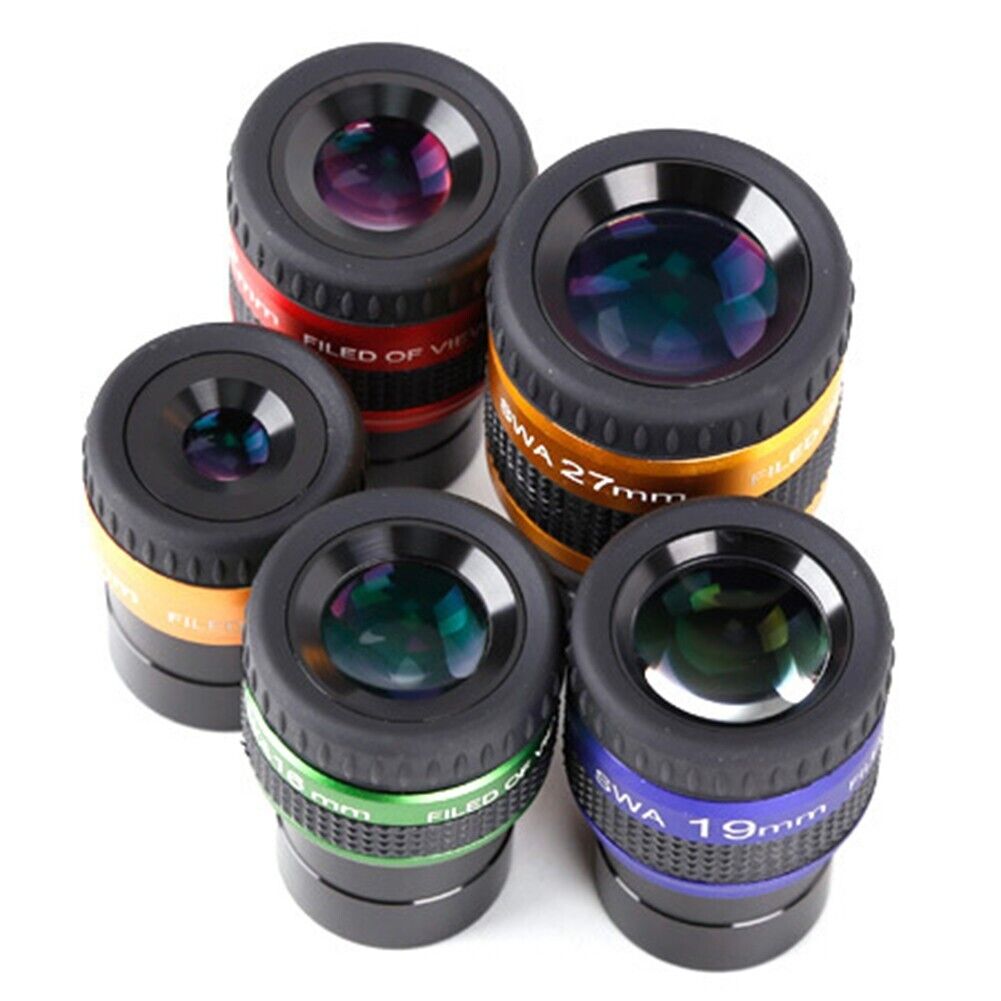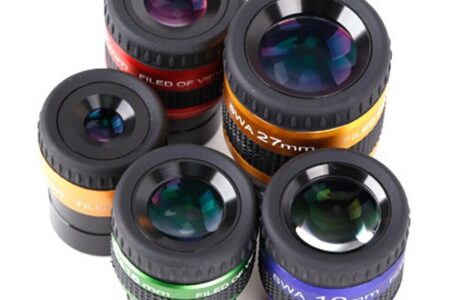When embarking on the captivating journey of stargazing or exploring the celestial wonders of the universe, the telescope stands as your trusty gateway to the cosmos. However, in the quest to obtain the clearest, most mesmerizing views of distant galaxies, stars, and planets, it’s not just the telescope itself that matters; the eyepiece plays an equally vital role. This article delves into the pivotal importance of quality eyepieces that come with a telescope, shedding light on how they enhance your astronomical experience.
A Window to the Universe: What Are Eyepieces?
Eyepieces, often referred to as oculars, are the optical components of a telescope that you look through to observe celestial objects. They are essentially the “windows” through which you peer into the vastness of space. Eyepieces are to telescopes what the lens is to a camera – they have the power to make or break the quality of your observations.
The Telescope-Eyepiece Symbiosis
Telescopes and eyepieces share a symbiotic relationship. Telescopes gather and magnify light, but it’s the eyepiece that allows you to see and interpret the magnified image. Without quality eyepieces, even the most sophisticated and powerful telescope can fall short of delivering breathtaking views of the cosmos.
Think of your telescope as a powerful camera lens, and the eyepiece as the viewfinder. Just as a high-quality lens is essential for capturing sharp and vibrant photographs, top-notch eyepieces are crucial for obtaining clear and detailed celestial images.
The Many Faces of Eyepieces
Eyepieces come in various shapes, sizes, and designs, each tailored to meet different observational needs. Understanding the types of eyepieces and their roles is essential to grasp the importance of quality.
1. Plossl Eyepieces
Plossl eyepieces are the workhorses of the astronomical world. They offer good eye relief, a comfortable viewing experience, and a wide field of view. These eyepieces are versatile and are often included with mid-range telescopes.
2. Wide-Angle Eyepieces
Wide-angle eyepieces provide a larger field of view, allowing you to observe more of the night sky at once. They’re especially useful for scanning star clusters, nebulae, and open clusters.
3. High-Magnification Eyepieces
For planetary and lunar observations, high-magnification eyepieces are indispensable. They allow you to zoom in on details and appreciate the intricate features of celestial bodies.
4. Barlow Lenses
While not technically eyepieces, Barlow lenses are optical accessories that, when used with eyepieces, effectively double or even triple the magnification. They’re excellent for close-up views of planets and the Moon.
5. Specialty Eyepieces
There are specialty eyepieces designed for specific purposes, such as hydrogen-beta filters for observing certain nebulae or solar eyepieces for safely viewing the Sun.
The Impact of Eyepiece Quality on Observations
Now that we’ve explored the different types of eyepieces, let’s delve into why the quality of these optical components is paramount for your astronomical endeavors.
1. Clarity and Sharpness
The most immediate impact of a quality eyepiece is the clarity and sharpness it brings to your observations. Inferior eyepieces can introduce distortions, blurriness, or chromatic aberrations, effectively undermining the resolution and detail of the celestial objects you’re observing.
Quality eyepieces, on the other hand, are crafted with precision optics, multiple lens elements, and anti-reflective coatings that minimize light scatter and aberrations. As a result, you’ll enjoy crisp, high-contrast views of the Moon’s craters, Jupiter’s bands, Saturn’s rings, and the intricate details of deep-sky objects.
2. Enhanced Contrast and Color Fidelity
Astronomy often involves observing faint objects against a backdrop of darkness. Low-quality eyepieces may fail to provide the necessary contrast to make these objects stand out. In addition, they may struggle to faithfully reproduce the subtle colors of certain stars and nebulae.
Quality eyepieces excel in contrast enhancement and color rendition. They reveal intricate details within nebulae, highlight the subtle color variations in stars, and bring out the elusive features of galaxies. This enhanced contrast and color fidelity can transform your stargazing experience from mediocre to extraordinary.
3. Comfortable Viewing Experience
Long hours of stargazing require a comfortable viewing experience. Quality eyepieces often incorporate features like long eye relief, adjustable eyecups, and ergonomic designs. These factors ensure that you can enjoy extended celestial observations without eye strain or discomfort.
4. Minimized Distortions and Aberrations
Distortions and aberrations, such as astigmatism or field curvature, can mar the viewing experience and frustrate astronomers. High-quality eyepieces are engineered to minimize these aberrations, delivering a flat field of view and pinpoint star images.
5. Compatibility with Other Accessories
Telescopes often allow for the interchangeability of eyepieces and accessories like Barlow lenses and filters. Quality eyepieces are designed to work seamlessly with these accessories, ensuring that you can customize your setup for various astronomical targets.
The Cost-Quality Conundrum
It’s no secret that quality eyepieces can be a significant investment, often costing a substantial portion of your overall telescope budget. This begs the question: are they worth the price?
1. A Long-Term Investment
Quality eyepieces are not just an accessory; they are an investment in your astronomical journey. Unlike telescopes, which may need upgrades as your skills and preferences evolve, high-quality eyepieces can serve you well for many years, across different telescopes.
2. Preservation of Resale Value
If you ever decide to upgrade your telescope, quality eyepieces can retain their value remarkably well in the second-hand market. They are sought after by fellow astronomers who recognize their significance, making them easier to sell or trade.
3. Unlocking the Full Potential of Your Telescope
Consider this: you’ve invested in a powerful telescope with a large aperture, but you compromise on eyepiece quality. The result? You may never fully experience the telescope’s true potential. High-quality eyepieces maximize the capabilities of your telescope, ensuring that you’re not held back by inferior optics.
4. Saving Money in the Long Run
While quality eyepieces may seem expensive upfront, they can save you money in the long run. Instead of constantly upgrading to new telescopes in search of better performance, you can enhance your existing setup with top-notch eyepieces, thus avoiding the cycle of costly telescope replacements.
Quality Eyepieces and Astronomical Imaging
Beyond visual observation, quality eyepieces also play a pivotal role in astronomical imaging, such as astrophotography and planetary photography. In these pursuits, the quality of the eyepiece directly affects the quality of the images you capture.
1. Sharp and High-Resolution Images
For astrophotography, the sharpness and resolution of your eyepiece impact the level of detail you can capture in your images. Low-quality eyepieces can introduce optical flaws that mar your photographs, while quality eyepieces deliver the clarity and precision necessary for stunning astrophotography.
2. Reduced Vignetting
Vignetting, the darkening of the corners in an image, can be a challenge in astrophotography. Quality eyepieces are designed to minimize vignetting, ensuring that your images have even illumination across the frame.
3. Minimized Coma and Distortions
Coma, an optical aberration that causes stars at the edge of the field of view to appear elongated, can plague astrophotographers. Quality eyepieces are engineered to minimize coma, producing pinpoint stars even at the periphery of your images.
4. Precise Focusing and Framing
When imaging celestial objects, precise focusing and framing are essential. High-quality eyepieces offer smooth and precise focus adjustments, making it easier to achieve the perfect focus for your shots.
5. Compatibility with Imaging Accessories
If you plan to delve into astrophotography, quality eyepieces are often designed with imaging in mind. They are compatible with camera adapters, T-rings, and other accessories needed for connecting your camera to the telescope.
The Role of Personal Preferences
While quality eyepieces undoubtedly elevate your astronomical experience, personal preferences and observing goals also come into play. Some astronomers may prioritize wide-field views for deep-sky explorations, while others may focus on planetary observations requiring high magnification. The choice of eyepieces should align with your unique interests and objectives.
How to Assess Eyepiece Quality
Now that you appreciate the significance of quality eyepieces, it’s essential to know how to evaluate them when considering a purchase. Several factors contribute to eyepiece quality:
1. Optical Coatings
Look for eyepieces with multi-coated or fully multi-coated optics. These coatings reduce reflections, improve contrast, and enhance light transmission, resulting in brighter and clearer views.
2. Glass and Lens Elements
Quality eyepieces often feature high-quality glass and multiple lens elements. Examine the specifications to ensure that the eyepiece uses premium materials.
3. Eye Relief
Consider the eyepiece’s eye relief, especially if you wear glasses while observing. Longer eye relief allows for comfortable viewing with or without corrective eyewear.
4. Field of View
Different eyepieces offer varying field-of-view sizes. Decide whether you need wide-angle eyepieces for panoramic views or narrower ones for high magnification.
5. Build Quality
Evaluate the eyepiece’s build quality, including the materials used and the presence of rubber grips or other ergonomic features. A robust eyepiece can withstand the rigors of regular use.
6. Brand Reputation
Reputable brands often produce high-quality eyepieces. Research and read reviews to identify trusted manufacturers.
7. Compatibility
Ensure that the eyepiece is compatible with your telescope’s focuser size and type. Some eyepieces may require adapters for certain telescope models.
Conclusion
Quality eyepieces are the unsung heroes of your astronomical journey, quietly shaping the way you perceive the cosmos. They are the gateway to crisp, clear, and breathtaking views of celestial wonders. While their price may seem daunting, the investment is one that pays off in the long run, both in terms of enhanced observation experiences and potential resale value.
In your quest to explore the universe, remember that your telescope is only as good as the eyepiece you use. Whether you’re an avid stargazer or an aspiring astrophotographer, quality eyepieces will always stand as a testament to the profound impact of precision optics in the pursuit of understanding the cosmos. So, as you peer through your telescope on a clear, starry night, savor the knowledge that it’s the quality of your eyepiece that makes the universe come alive before your eyes.

